Performance & Battery Life Report: Xiaomi Redmi Note 4 with MediaTek Helio X20
by Matt Humrick on February 23, 2017 7:00 AM EST- Posted in
- Smartphones
- Mobile
- Xiaomi
- MediaTek
- Helio X20
- Redmi Note 4
CPU & System Performance
The Redmi Note 4 has two power settings: Performance and Balanced (default). Normally settings like these alter DVFS and/or scheduler behavior, giving the user a choice between better performance or longer battery life. On the Redmi Note 4, however, with the Chinese ROM I tested, these settings do nothing. Monitoring DVFS behavior under a variety of workloads revealed no discernible difference between the settings, which was confirmed by essentially identical scores in all of our performance tests.
The PCMark Work 2.0 suite evaluates overall system performance, testing the combined effects of the CPU, GPU, RAM, and NAND storage. Because it uses standard Android API calls and runs several different real-world workloads that elicit realistic behavior from the CPU governor (unlike synthetic tests that simply run one or more CPUs at max frequency), it’s a good indicator of everyday performance.
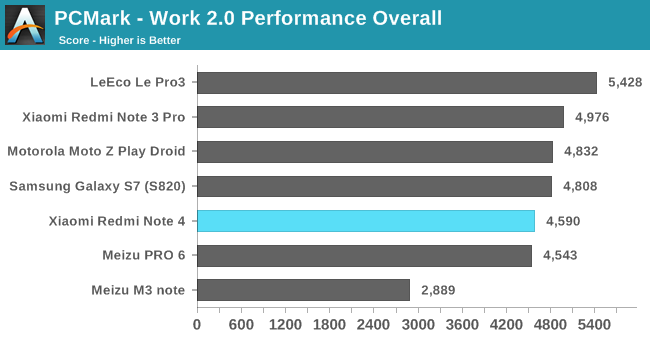
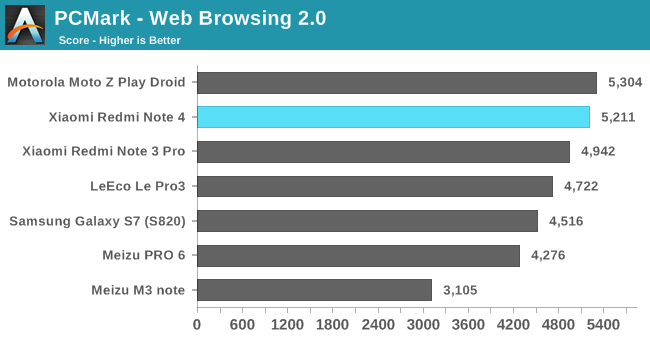
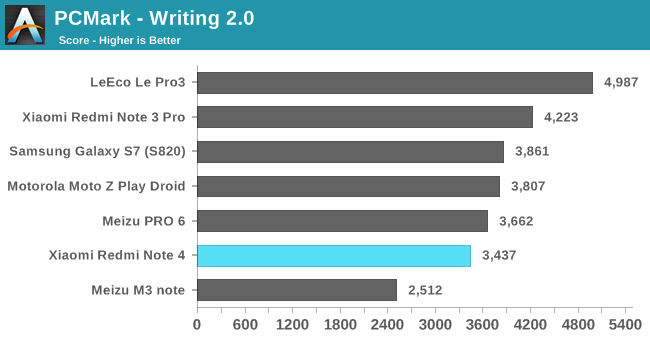

Looking at the overall results first, the Redmi Note 4 matches the performance of the Meizu Pro 6 and falls just shy of Samsung’s Galaxy S7 (Snapdragon 820) and Xiaomi’s Redmi Note 3 Pro, which is just 8% faster; however, looking at the individual subtest scores shows that larger differences exist between these phones.
In the Web Browsing test, the Redmi Note 4 performs quite well, outpacing the Meizu Pro 6 and its higher clocked Helio X25 by 22%. Despite the new load threshold values, it appears Meizu’s implementation is still a bit conservative considering the X25’s Max CPU cluster has a 20% peak frequency advantage over the X20 in the Redmi (the advantage for its Mid CPU cluster is 8.5%). The Redmi Note 4 also finishes ahead of both Snapdragon 820/821 phones as well as the older Redmi Note 3 Pro.
The finishing order in the Writing test, whose workload tends to migrate threads to the big CPU cores more often than the Web Browsing test, is quite different. Here we see the Meizu Pro 6 pull ahead of the Redmi Note 4 by a small 6.5% margin, which is more inline with expectations; however, the Redmi Note 3 Pro is 23% faster than the newer model in this test.
The Data Manipulation test, which measures how long it takes to parse data from several different file types and then records the frame rate while interacting with dynamic charts, jumbles up the results once again, demonstrating how diverse workloads can elicit different levels of performance that are affected more by the software parameters that govern scheduler and DVFS behavior than the speed of the underlying hardware.
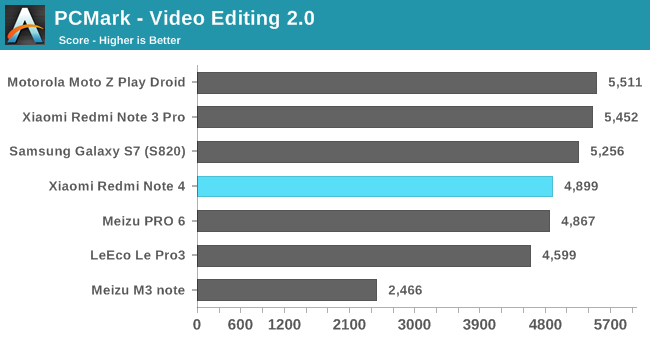

A significant portion of the Video and Photo Editing workloads utilizes GPU compute, so it’s no surprise that the Redmi Note 4 and Meizu Pro 6, which use the same GPU, show similar performance. The Photo Editing test is far more intense, resulting in a larger performance gap between the Galaxy S7 and LeEco Le Pro3, which use Snapdragon 820 and 821 SoCs, respectively, and the phones with lower-performing GPUs.
Since the Redmi Note 4 is still running Android 6, I was hoping to run DiscoMark to measure the time it takes to open and switch between several common apps (DiscoMark does not work with Android 7); unfortunately, Xiaomi’s MIUI kept interfering and would not reliably allow DiscoMark to open or switch apps via Android's accessibility services. I did not encounter this issue when testing older versions of the global ROM, so this is either a new “feature” or a behavior specific to the Chinese ROM.

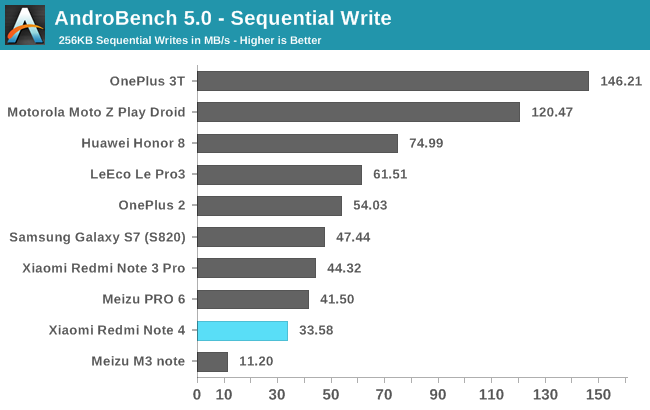
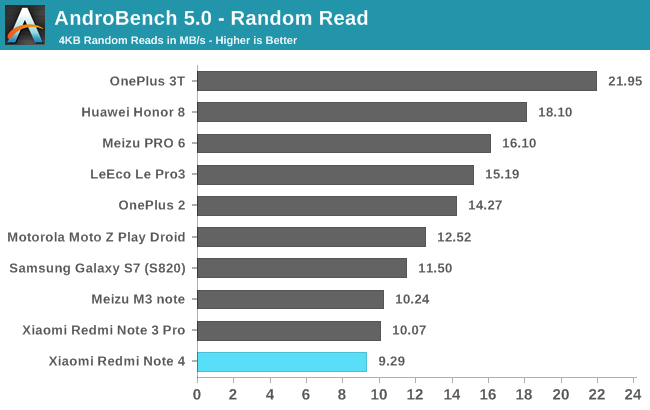
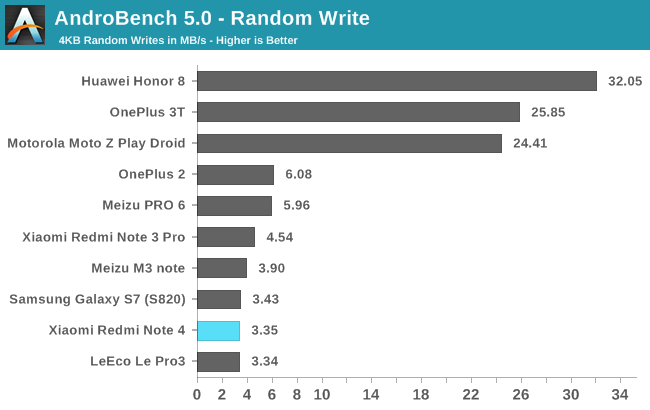
The Redmi Note 4’s internal storage performance is rather poor. Sequential reads fail to break the 100 MB/s mark—less than half the performance of the older Redmi Note 3 Pro—and its sequential write and random I/O performance are hardly any better. Thinking the results may be in error, I ran a different storage test on both Redmi phones that also measured sequential and random patterns for 4KB, 16KB, and 256KB I/O sizes, and while the margins were slightly different, the end result was the same: The Redmi Note 3 Pro outperformed the Redmi Note 4 in every test.
These results did not agree with my subjective experience while using the phone, however. For example, the Redmi Note 4 launches apps just as quick as the Redmi Note 3 Pro. Curious, I dug deeper by performing some local file copy tests. In the first test, I copied a 300MB file and the Redmi Note 3 Pro finished sooner but just barely. I then copied a much larger file, almost 1.4GB, and the Note 4 finished well ahead of the Note 3 Pro. Even copying 1,000 small ~2KB text files, the contents of which varied only slightly, proved faster with the Note 4.
| Sequential Storage Performance (AndroBench 5.0) | ||||||||
| Sequential Read (KB) | Sequential Write (KB) | |||||||
| 1024 | 2048 | 4096 | 8192 | 1024 | 2048 | 4096 | 8192 | |
| Redmi Note 4 | 99.98 | 129.62 | 141.12 | 178.60 | 55.41 | 81.51 | 103.62 | 118.33 |
| Redmi Note 3 Pro | 203.57 | 220.97 | 234.01 | 233.38 | 62.16 | 68.07 | 70.59 | 73.54 |
| % Difference | -50.9% | -41.3% | -39.7% | -23.5% | -10.9% | 19.7% | 46.8% | 60.9% |
The table above shows how the Note 4’s storage performance scales better than the Note 3 Pro’s for both sequential reads and writes with increasing I/O sizes. Most file operations outside reading and writing photos and video will not trigger such large chunks, but in certain cases, like the file copy examples above, the Linux page cache, which improves disk I/O by caching all file reads and writes in RAM, allows multiple small files to coalesce and be written to NAND in one larger chunk, effectively hiding the Note 4’s weakness with small I/O.
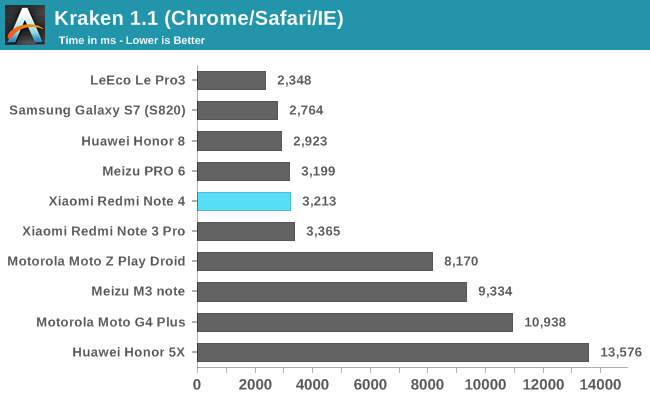
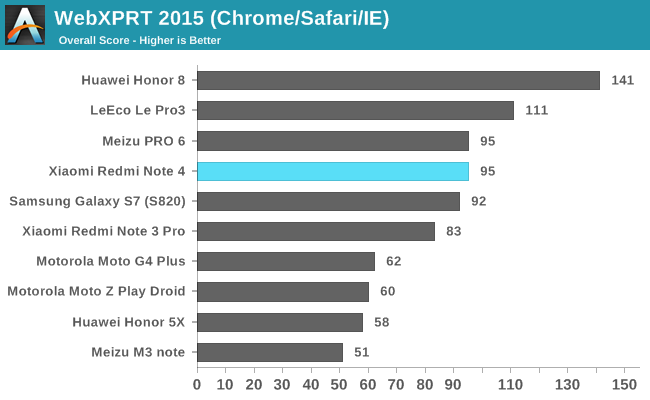
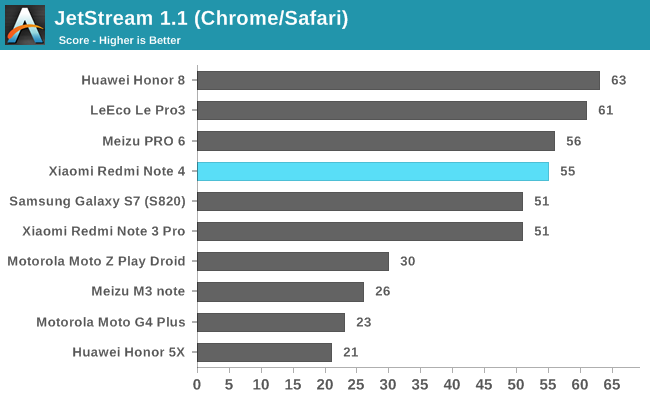
In all three JavaScript tests, the Helio X20 and X25 SoCs in the Redmi Note 4 and Meizu Pro 6, respectively, perform essentially the same. The Snapdragon 650 SoC in the Redmi Note 3 Pro has two A72 cores like both Helio SoCs, but they top out at 1.8GHz. Its four A53 cores (1.4GHz) are also slower than the Helio’s A53 Mid clusters, putting it at a disadvantage in these tests that are especially sensitive to CPU frequency. The Redmi Note 4 outperforms the older model in all three tests by 5% to 15%. The four devices with octa-core A53 CPU configurations fall to the bottom of the pack by a noticeable margin.
Overall Xiaomi’s Redmi Note 4 performs quite well. Just as we saw with the Redmi Note 3 Pro and its Snapdragon 650 SoC, the inclusion of two A72 CPU cores in the Note 4’s Helio X20 gives it a huge advantage over the octa-core A53 configurations prevalent at this price point. Its Web browsing performance is very good, it opens apps pretty quickly, and its user interface and scrolling performance is mostly fluid with only occasional hiccups. The speed of the onboard NAND when handling small I/O is disappointing, but it’s not really noticeable during normal use. Its modest GPU also falls behind when handling GPU compute workloads, increasingly found in photo and video editing apps.










34 Comments
View All Comments
serendip - Thursday, February 23, 2017 - link
Isn't there a new Redmi Note 4 variant with a Snapdragon 625? XDA reviewed that, comparing it with the older 652-based Note 3 and found that the newer phone was slightly slower but had even better battery life.As for Mediatek... They're serial violators of the GPL, enough said.
BMNify - Thursday, February 23, 2017 - link
Snapdragon version is being sold in India and Mediatek version is being sold in China.h0007h - Friday, February 24, 2017 - link
625 version is also sold in China, which is named Redmi Note4Xjospoortvliet - Monday, February 27, 2017 - link
It seems the Mediatek is at least a big part of the reason for the lower battery life, GPL violations and resulting lack of support longevity aside. That the 625 is slower with longer battery life makes sense given its octa core a53. Dropping the higher performing a72's for more but slower a53's is not a step forward unless all you care about is battery life...djayjp - Thursday, February 23, 2017 - link
Wish the OnePlus 3T was in all the benchmark results, not just the storage ones....Lodix - Thursday, February 23, 2017 - link
Matt the X20 is a lower binmed SOC so it has worse thermals and power consumption compared to the higher binned X25.Matt Humrick - Thursday, February 23, 2017 - link
Even if the X25's A72 cores could reach 2.5GHz at the same voltage as the X20's at 2.1GHz, the X25's A72 dynamic power would still be higher based on the increase in frequency. While I would need a measurement to confirm this, I suspect that with a mature 20nm planar process that the X25 would need additional voltage to hit 2.5GHz. The Meizu Pro 6's operating table (which usually are not 100% accurate) at least suggests the X25's voltage is higher.In order for the X20 to consume more power and produce more heat than the X25 as you suggest (at least for the big CPU cores), the X25's A72 cores would need both a 19% increase in frequency and an 8% reduction in voltage, which seems unlikely.
zodiacfml - Thursday, February 23, 2017 - link
Nice. I can't wait for the X30.dexterkarthik - Thursday, February 23, 2017 - link
Redmi Note 4 international variant is a joke.I doesn't have the dual WiFi band as the RN3, downgraded camera pixel count, downgraded CPU and GPU (redmi3s is >90% a RN4 for almost half the price in India).
I love this strategy to an extent since it makes me feel happy to own the RM3 for getting 3/4th OnePlus 3 performance for 1/3rd price and since most run behind core count and "LATEST" version, RN3 will start getting discounts and sale, etc :D .
WPX00 - Friday, February 24, 2017 - link
The SD625 is a more significant bump to the 617 or 430 than you might expect. GPU is 2-2.5x more powerful, its 14nm process is 35% more efficient, and the CPU is 1.5-2x more powerful thanks to the greater thermal headroom 14nm brings. It is a massive leap forward, in my opinion, a more significant leap than the jump from quad to octa (410 to 61x series).